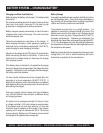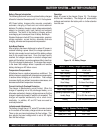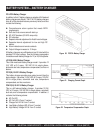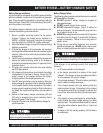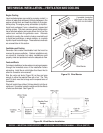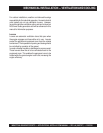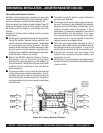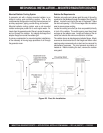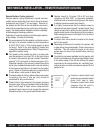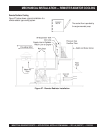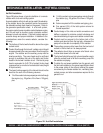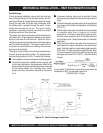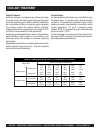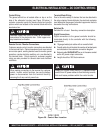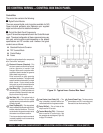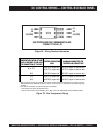
PAGE 64 — INDUSTRIAL GENERATOR SETS — APPLICATION & INSTALLATION MANUAL — REV. #4 (09/07/07)
Remote Radiator Cooling (optional)
Remote radiator cooling substitutes a remote mounted
radiator and an electrically driven fan for the set mounted
components (see Figure 27 on next page). Removal of
the radiator and the fan from the set reduces noise levels
without forcing dependence on a continuous cooling water
supply. The remote radiator installation must be completely
protected against freezing conditions.
Application of a remote radiator to cool the engine requires
proper design. Consider the following:
It is recommended that the radiator and fan be sized on
the basis of a maximum radiator top tank temperature
of 200°F (93°C) and a 115% cooling capacity to allow
for fouling. Refer to the
heat rejected to coolant
and
coolant flow rate
specifications in Table 27 beginning on
page 88 for radiator sizing.
The capacity of the radiator top tank or auxiliary tank
must be equivalent to at least 15% of the total volume
of coolant in the system to provide a coolant "drawdown
capacity" (10%) and space for thermal expansion (5%).
Drawdown capacity is the volume of coolant that can be
lost by slow, undetected leaks and the normal relieving
of the pressure cap before air is drawn into the coolant
pump. Space for thermal expansion is created by the
fill neck when a cold system is being filled.
To reduce radiator fin fouling, radiators have a more open
fin spacing (nine fins or less per inch) should be
considered for dirty environments.
Coolant friction head external to the engine (pressure
loss due to pipe, fitting, and radiator friction) and coolant
static head (height of liquid column measured from
crankshaft center line) must not exceed the maximum
allowable values on the genset specification sheet.
MECHANICAL INSTALLATION — REMOTE RADIATOR COOLING
Radiator hose 6 to 18 inches (152 to 457 mm) long,
complying with SAE 20R1, or equivalent standards,
should be used to connect coolant piping to the engine
to absorb genset movement and vibration.
It is highly recommended that the radiator hoses be
clamped with two premium grade "constant-torque" hose
clamps at each end to reduce the risk of sudden loss of
engine coolant due to a hose slipping off from pressure.
Major damage can occur to an engine if it is run without
coolant in the block.
A coolant drain valve should be located at the lowest
part of the system.
Depending on the amount of coolant in the system, ball
or gate valves are recommended. Globe valves are too
restrictive. This will isolate the engine so the entire
system does not have to be drained before servicing
the engine.
To obtain the
net power
available from the genset, add
the fan load indicated on the genset specification sheet
to the power rating of the set and subtract the power
consumed by the remote radiator fan, ventilating fans,
coolant pumps, and other accessories required for the
genset to run.
Excessive coolant static head
(pressure) can cause the coolant
pump shaft seal to leak.
Excessive coolant friction head
(pressure loss) will result in
insufficient engine cooling.
NOTE



